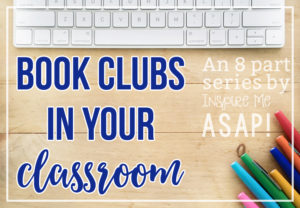
This post is the first in an 8 part series that I will write about implementing book clubs into your classroom. Today I will write an introduction about book clubs and dive further into the different parts of book clubs as the weeks progress.
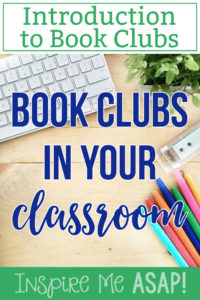
I have been implementing literature circles with my students for (at least) the past 5 years. I visited my local libraries and checked out multiple copy books. I introduced literature circles with a couple mini-lessons during my reading workshop time, specifically focusing on how to shop for a book, participating in a group discussion, and completing their assigned “job.”
However, for the past few years, I have spent a considerable amount of time researching and learning about best practices when it comes to having your students meet with their peers to talk about the books they are reading. As a result, I have grown so much with my understanding of how to successfully implement groups in my classroom. First and foremost, I changed the name from Literature Groups to Book Clubs.
Simply put, book clubs are a group of readers who meet regularly to discuss books they select.

Book clubs are NOT reading groups, guided reading groups, literature groups, round robin reading, or reading workshop.
Instead, book clubs focus on open-ended, genuine, student-led discussions, without being tied down to their assigned “roles” or “jobs.” (This is NOT to say that roles/jobs are a bad thing- in fact, they can be helpful for students who need more guidance with their meetings and discussions.) In my experience, role sheets limits genuine, natural conversations among group members. When I first implemented literature circles, I assigned each student a specific job and assigned them a job title. For fiction books, I named the jobs passage performer, vivid visualizer, king/queen of questions, word whiz, incredible illustrator, and so on. For nonfiction books, I had different job titles, such as news reporter, fascinating fact finder, graph guru, and so on.
Instead of feeding off of each other comments, the role sheets dictated who spoke and what they talked about. When every member shared their job sheet, the meeting was over. When my students were independently reading the text, their brain was focused on one reading strategy- the one that I assigned them. Unfortunately, I didn’t realize at the time that this was limiting their potential.
Now, instead of teaching mini-lessons about the different jobs and how to fill out the job sheets, I focus my reading workshop mini-lessons on explicitly teaching how to hold engaging, deep discussions that piggyback off of each other. Instead of using job sheets, each student uses their book as the main focus of each and every meeting, finding and citing evidence to support their opinions and ideas. Book club members have the opportunity to be flexible about what they want to discuss and the agenda for the day. Although some days I may have the students focus on one talking point, such as identifying secondary characters and their impact on the main character’s journey, other times group members take ownership over the items on their agenda.
Since my students are not focused on one strategy, such as writing down questions they have for their job sheet, they are now able to use multiple metacognition strategies as they are reading the text independently. Another way to think about this is to reflect on your own book clubs. Think about a book that you read with your coworkers, church group, or friends. What if the group leader gave you only one specific job to focus on and that would be what you talked about If you were reading a book with your book club,
If you walked into my classroom during literature groups, you would see:
About 5 to 6 groups of students scattered around the room. Each group would have 4 or 5 students in each group. All members sit in a circle facing each other. Each member brings their pencil, the book club book, and the job sheet. The “role” or “job” sheet drove the discussion. One at a time, each student shared what they wrote by reading their job sheet. After each member shares their job sheet, the group meeting concludes by assigning the portion of the text to read and dismisses. The teacher walks around and takes notes about what he/she observes from each group members. The meeting ends and each student reads the assigned portion of the text independently.
If you walked into my classroom during book clubs, you would see:
About 5 to 6 groups of students scattered around the room. Each group would have 4 or 5 students in each group. All members sit facing each other and come prepared with their materials- book club book, pencil, sticky notes, reading response journal. Prior to meeting with their group, each member checks the book club bulletin board to make sure they completed their assigned reading and work as agreed on at the last meeting. A rich, student-led discussion about the assigned reading begins. Students are flipping through their books, excitedly proving their opinions by showing where something happened in the book. Students may respond by saying, “I respectfully disagree with you because…” All group members are encouraged to participate. The teacher walks around and takes notes about what he/she observes from each group members. Group members use an agenda to keep them on track and edit the daily agenda as necessary. Group members discuss their next steps and post their assignment on the book club bulletin board. All groups and the teacher can easily see the goals and hard work of each group. The meeting ends and each student reads the assigned portion of the text independently.
Speaking of what book clubs LOOK like and SOUND like… that is exactly two of the mini-lessons that I teach my students as I first introduce book clubs.
Below is a picture of the anchor chart that I create when I teach a mini-lesson about what book clubs “look like”. I love to add real photographs of my students in anchor for my anchor charts! It is so motivating for my students to see me taking their picture and then using it for our anchor chart.
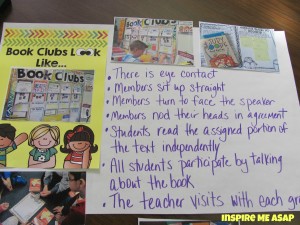
Characteristics of what book clubs LOOK like include:
- There is eye contact with all group members
- Members sit up straight…no slouching
- Members turn to face the speaker
- Members nod their heads in agreement
- Students read the assigned portion of the text independently
- All students participate by talking about the text
- The teacher visits with each group
After introducing these initial characteristics of book clubs, we add to our anchor charts during our first round. I like the students to take ownership for adding their own ideas to this initial anchor chart. For example, one group added, “Members have their hands folded in their lap and are not fidgeting with their pencil or book.”
Below is a picture of the anchor chart that I create when I teach a mini-lesson about what book clubs “sound like”. You will notice that there is nothing “cute” about this anchor chart. I wanted to show you this picture because this is what I *really* used with my students. Yes, ideally I would love for it to have beautiful graphics and photographs of my students…there are sometimes when it does not happen! With that being said, it is the content on the anchor chart that matters!
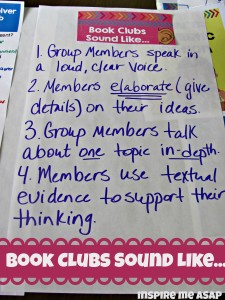
Characteristics of what book clubs SOUND like include:
- Group members speak in a loud, clear voice
- Group members elaborate (give details) on their ideas
- Group members talk in-depth about one topic
- Group members use textual evidence to support their thinking
Just like with the “look like” anchor chart, we also add more characteristics to this anchor chart as we move through our first round of book clubs.
In my upcoming blog posts, I will break down each of the topics into chapters:

Upcoming topics:
Chapter One: Introduction to book clubs
Chapter Two: Benefits of book clubs
Chapter Three: Matching books to readers
Chapter Four: Book club expectations
Chapter Five: Accountability with book club members
Chapter Six: Student-led conversations in book clubs
Chapter Seven: Role of the teacher in book clubs
Chapter Eight: Using assessments in book clubs
What questions do you have about any one of these topics? Feel free to email me or write a comment with your question. I would *love* to help you figure out how to successfully implement book clubs into YOUR classroom!
Looking for a resource to help you implement book clubs in your classroom?
Check out my Resource below:

Looking for an engaging and sure-fire way to motivate your readers? This 107 page file has everything you need to know in order to effectively implement a book clubs with your rockin’ readers, while meeting the CCSS for Speaking and Listening.
There are 15 mini-lessons that are included in this file, which focus on establishing routines and setting expectations for book clubs with your students.
Mini-lessons include:
Detailed lesson plans
Colorful posters for you to print for your anchor charts
Reproducibles for your students

During this unit, readers will learn to:
-Define book clubs and understand its importance
-Describe characteristics of what book clubs LOOK like
-Describe characteristics of what book clubs SOUND like
-Book club members are assigned
-Commit to expected behaviors
-Shop for a book
-Follow agendas to stay on task
-Prepare for group meetings
-Read assigned portions of text and take notes about what they read
-Participate in a group discussion
-Share their opinions with group members
-Keep conversations on-task and focused
-Compromise and problem solve when issues arise
-Use prompts to guide their discussions
-Self-reflect and evaluate their performance
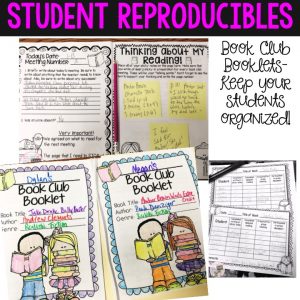
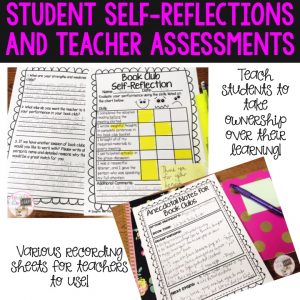
Also included in this unit:
-A note to send home to parents
-Tips for teachers about implementing book clubs successfully
-Detailed rubrics for teachers and students
-Bulletin board resources, where each group can post their group name, picture, assignment, and other important information
This Book Club Resource is also part of my Reading Workshop BUNDLE
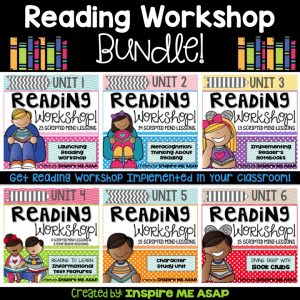
Click HERE to purchase Book Clubs on Teachers Pay Teachers.
Save 10% by purchasing directly through my website.



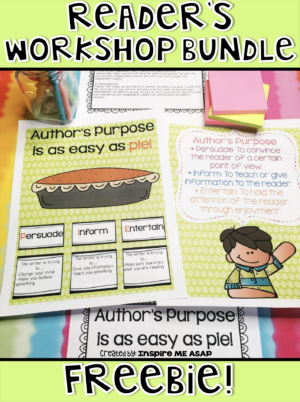





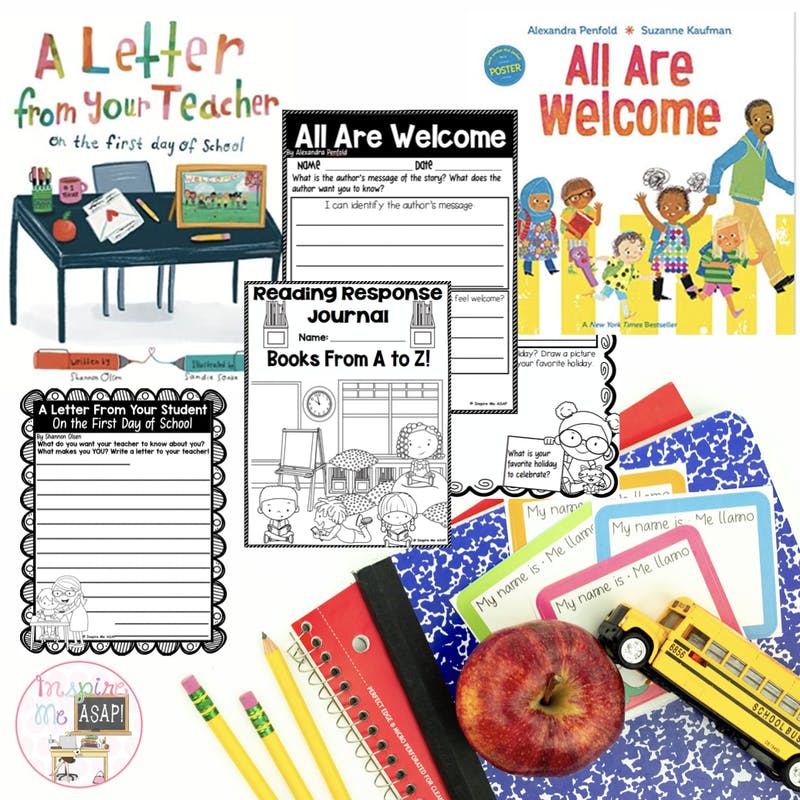
10 Responses
What a great blog post! I had a very similar experience with literature circles- I found using role sheets really limited my students’ discussions, and I moved away from the traditional role sheet. I can’t wait to read the rest of your series!
Hi Deb,
Thank you so much for your kind words! I absolutely love book clubs and I am so happy that other teachers have the same passion for them! :)
Thanks again,
Melissa :)
This is great! Right now I am doing a version of the literacy circles. I love this idea much better! Just to be sure in book clubs they are reading the same book correct? I also have a few questions for you. Do you assign homework if they do not finished their assigned reading? What if they did not do what they were supposed to do for their next group meeting? How often do you have group meetings? I would love to see a closer picture of your bulletin board where they keep their assignments!
Hello Ashley!
Thanks so much for your questions! I appreciate you taking the time to write to me. Those are great questions that I will make sure to answer in my future posts about book clubs. Short answers- YES! They all read the same text. The accountability for finishing reading/work is one of my next posts. As for the frequency of meetings- about two to three times (no more, no less!) per week. I do have a picture of my bulletin board I will share on my Chapter 5 post.
Thanks again, Ashley!
Melissa :)
I look forward to your posts!! :)
Melissa, this is a great resource! I am brand new to third grade and appreciate this thorough, step by step guidance! One question as I try to wrap my head around this- do you give the students class time to do their independent reading, or is that done at home/ if they get done with something early? I know you will probably cover all of this in the coming weeks, I was just wondering about how that would look in the structure of the school day. I truly cannot wait for more!
Hello Anna!
Thanks so much for your kind words. I am so happy these posts are helpful for you. I use a reading workshop approach to teach reading. I begin my reading block with a mini-lesson, which is whole group. Then, I ask the students to meet with their book club group to discuss one of my prompts or items they created on their own agenda. After meeting with their group, they go to independent reading at their seats. During this time, they read the assigned portion of the text and write their reflections. I conference with students/meet with groups during this time. I hope this helps!!!! :) Good luck! :)
Thank you for sharing your approach to book clubs in the classroom. Your information is so valuable! I had a couple of questions that could possibly be answered in upcoming blogs, but I thought I would ask. Are your students meeting with book club groups each day? If not, are they reading other books during workshop time (this would mean they are actively reading 2 books at once, just not the same book each day). I would love to hear more about how you meet with groups during reading workshop. Do you interrupt their reading to work with them in small group on skills non related to book club or do you discuss book club reading with them? Once challenge I am battling is getting to each group and each member being at a different spot in their reading when I meet with my 2nd and 3rd groups.
I struggle not discussing their daily reading with them each day. I wondered how you make this happen with each club.
Sorry for such a long comment. I love book clubs and want to be sure I can utilize them as effective and worthwhile as possible!
Thanks :)
Hi love this! Wanted to let you know there is a typo on the last line of second paragraph :)
Thank you so much for this post series, so many wonderful ideas. I am trying to come up with a way to implement something similar in 1st grade in a class with a number of high readers who are comfortable with chapter books but not independent comprehension wise… any tips?